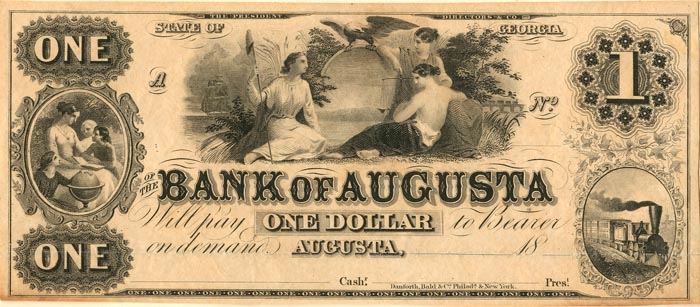Bank of Augusta - Obsolete Banknote - Paper Money
Inv# OB1365 Paper Money
Augusta (/əˈɡʌstə/ ə-GUSS-tə), officially Augusta–Richmond County, is a consolidated city-county on the central eastern border of the U.S. state of Georgia. The city lies across the Savannah River from South Carolina at the head of its navigable portion. Georgia's third-largest city after Atlanta and Columbus, Augusta is located in the Fall Line section of the state.
According to the U.S. Census Bureau, Augusta–Richmond County had a 2020 population of 202,081, not counting the unconsolidated cities of Blythe and Hephzibah. It is the 116th largest city in the United States. The process of consolidation between the City of Augusta and Richmond County began with a 1995 referendum in the two jurisdictions. The merger was completed on July 1, 1996. Augusta is the principal city of the Augusta metropolitan area. In 2020 it had a population of 611,000, making it the second-largest metro area in the state. It is the 95th largest metropolitan area in the United States.
Augusta was established in 1736 and is named in honor of Princess Augusta of Saxe-Gotha (1719–1772), the bride of Frederick, Prince of Wales and the mother of the British monarch George III. During the American Civil War, Augusta housed the principal Confederate powder works. Augusta's warm climate made it a major resort town of the Eastern United States in the early and mid-20th century. Internationally, Augusta is best known for hosting The Masters golf tournament each spring. The Masters brings over 200,000 visitors from across the world to the Augusta National Golf Club. Membership at Augusta National is widely considered to be the most exclusive in the sport of golf across the world.
Augusta lies approximately two hours east of downtown Atlanta by car via I-20. The city is home to Fort Gordon, a major U.S. Army base. In 2016, it was announced that the new National Cyber Security Headquarters would be based in Augusta.
The area along the river was long inhabited by varying cultures of indigenous peoples, who relied on the river for fish, water and transportation. The site of Augusta was used by Native Americans as a place to cross the Savannah River, because of its location on the fall line.
In 1735, two years after James Oglethorpe founded Savannah, he sent a detachment of troops to explore the upper Savannah River. He gave them an order to build a fort at the head of the navigable part of the river. The expedition was led by Noble Jones, who created a settlement as a first line of defense for coastal areas against potential Spanish or French invasion from the interior. Oglethorpe named the town in honor of Princess Augusta, the mother of King George III and the wife of Frederick, Prince of Wales. Oglethorpe visited Augusta in September 1739 on his return to Savannah from a perilous visit to Coweta Town, near present-day Phenix City, Alabama. There, he had met with a convention of 7,000 Native American warriors and concluded a peace treaty with them in their territories in northern and western Georgia. Augusta was the second state capital of Georgia from 1785 until 1795 (alternating for a period with Savannah, the first).
Augusta developed rapidly as a market town as the Black Belt in the Piedmont was developed for cotton cultivation. Invention of the cotton gin made processing of short-staple cotton profitable, and this type of cotton was well-suited to the upland areas. Cotton plantations were worked by slave labor, with hundreds of thousands of slaves shipped from the Upper South to the Deep South in the domestic slave trade. Many of the slaves were brought from the Lowcountry, where their Gullah culture had developed on the large Sea Island cotton and rice plantations.
During the Civil War, Augusta was home to many war industries including powder-works facilities. After the war, Augusta had a booming textile industry leading to the construction of many mills along the Augusta Canal to include Enterprise Mill, Sibley Mill, and King Mill.
The city experienced the Augusta Fire of 1916, which damaged 25 blocks of the town and many buildings of historical significance.
As a major city in the area, Augusta was a center of activities during Reconstruction and after. In the mid-20th century, it was a site of civil rights demonstrations. In 1970 Charles Oatman, a mentally disabled teenager, was killed by his cellmates in an Augusta jail. A protest against his death broke out in a riot involving 500 people, after six black men were killed by police, each found to have been shot in the back. The noted singer and entertainer James Brown was called in to help quell lingering tensions, which he succeeded in doing.









Ebay ID: labarre_galleries